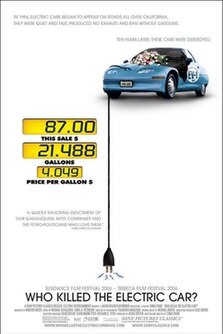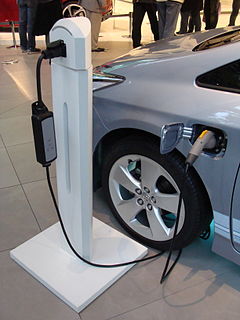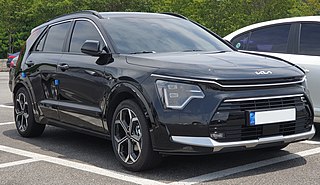
An electric vehicle (EV) is a vehicle that uses one or more electric motors for propulsion. It can be powered by a collector system, with electricity from extravehicular sources, or it can be powered autonomously by a battery. EVs include, but are not limited to, road and rail vehicles, surface and underwater vessels, electric aircraft and electric spacecraft.

Practical electric vehicles appeared during the 1890s. An electric vehicle held the vehicular land speed record until around 1900. In the 20th century, the high cost, low top speed, and short-range of battery electric vehicles, compared to internal combustion engine vehicles, led to a worldwide decline in their use as private motor vehicles. Electric vehicles have continued to be used for loading and freight equipment and for public transport – especially rail vehicles.

BYD Auto Co., Ltd. is the automotive subsidiary of the publicly-listed Chinese multinational manufacturer BYD Company, headquartered in Xi'an, Shaanxi Province, China. It was founded in January 2003, following BYD Company's acquisition of Qinchuan Automobile Company in 2002. The company produces passenger cars, buses, trucks, electric bicycles, forklifts and rechargeable batteries. The current model range of automobiles includes battery electric vehicles (BEVs) and plug-in hybrid electric vehicles (PHEVs), and the company also produced petrol engine vehicles up until March 2022.

A plug-in hybrid electric vehicle (PHEV) is a hybrid electric vehicle whose battery pack can be recharged by plugging a charging cable into an external electric power source, in addition to internally by its on-board internal combustion engine-powered generator. Most PHEVs are passenger cars, but there are also PHEV versions of commercial vehicles and vans, utility trucks, buses, trains, motorcycles, mopeds, and even military vehicles.

The Honda Clarity is a nameplate used by Honda on alternative fuel vehicles. It was initially used only on hydrogen fuel-cell electric vehicles such as the 2008 Honda FCX Clarity, but in 2017 the nameplate was expanded to include the battery-electric Honda Clarity Electric and the plug-in hybrid electric Honda Clarity Plug-in Hybrid, in addition to the next generation Honda Clarity Fuel Cell. Clarity production ended in August 2021 with US leases for the fuel cell variant continuing through to 2022.

Plug In America (PIA) is a 501(c)(3) non-profit educational organization that promotes and advocates the use of plug-in cars, trucks and sports utility vehicles (SUVs) powered by domestic and renewable electricity which it claims will help reduce dependence on fossil fuels, improve the global environment and reduce greenhouse gases and climate change.

Who Killed the Electric Car? is a 2006 American documentary film directed by Chris Paine that explores the creation, limited commercialization and subsequent destruction of the battery electric vehicle in the United States, specifically the General Motors EV1 of the mid-1990s. The film explores the roles of automobile manufacturers, the oil industry, the federal government of the United States, the California government, batteries, hydrogen vehicles and consumers in limiting the development and adoption of this technology.

The history of plug-in hybrid electric vehicles (PHEVs) spans a little more than a century, but most of the significant commercial developments have taken place after 2002. The revival of interest in this automotive technology together with all-electric cars is due to advances in battery and power management technologies, and concerns about increasingly volatile oil prices and supply disruption, and also the need to reduce greenhouse gas emissions. Between 2003 and 2010 most PHEVs on the roads were conversions of production hybrid electric vehicles, and the most prominent PHEVs were aftermarket conversions of 2004 or later Toyota Prius, which have had plug-in charging and more lead-acid batteries added and their electric-only range extended.

An electric car, battery electric car, or all-electric car, is an automobile that is propelled by one or more electric motors, using only energy stored in batteries. Compared to internal combustion engine (ICE) vehicles, electric cars are quieter, have no exhaust emissions, and lower emissions overall. In the United States and the European Union, as of 2020, the total cost of ownership of recent electric vehicles is cheaper than that of equivalent ICE cars, due to lower fueling and maintenance costs. Charging an electric car can be done at a variety of charging stations; these charging stations can be installed in both houses and public areas.

A plug-in electric vehicle (PEV), also known as new energy vehicle (NEV) in China, is any road vehicle that can utilize an external source of electricity to store electrical power within its onboard rechargeable battery packs, which then powers the electric motor and contributes to propelling the wheels. PEV is a subset of electric vehicles, and includes all-electric/battery electric vehicles (BEVs) and plug-in hybrid vehicles (PHEVs). Sales of the first series production plug-in cars began in December 2008 with the introduction of the plug-in hybrid BYD F3DM, and then with the all-electric Mitsubishi i-MiEV in July 2009, but global retail sales only gained traction after the introduction of the mass production all-electric Nissan Leaf and the plug-in hybrid Chevrolet Volt in December 2010.

The adoption of plug-in electric vehicles in the United States is supported by the American federal government, and several states and local governments. As of December 2021, cumulative sales in the U.S. totaled 2.32 million highway legal plug-in electric cars since 2010, led by all-electric cars. The American stock represented 20% of the global plug-in car fleet in use by the end of 2019, and the U.S. had the world's third largest stock of plug-in passenger cars after China (47%) and Europe (25%).

Electric car use by country varies worldwide, as the adoption of plug-in electric vehicles is affected by consumer demand, market prices, availability of charging infrastructure, and government policies, such as purchase incentives and long term regulatory signals.

Government incentives for plug-in electric vehicles have been established around the world to support policy-driven adoption of plug-in electric vehicles. These incentives mainly take the form of purchase rebates, tax exemptions and tax credits, and additional perks that range from access to bus lanes to waivers on fees. The amount of the financial incentives may depend on vehicle battery size or all-electric range. Often hybrid electric vehicles are included. Some countries extend the benefits to fuel cell vehicles, and electric vehicle conversions.

The fleet of light-duty plug-in electric vehicles in Japan totaled just over 300,000 highway legal plug-in electric vehicles in circulation at the end of 2020, consisting of 156,381 all-electric passenger cars, 136,700 plug-in hybrids, and 9,904 light-commercial vehicles.

The stock of new energy vehicles in China is the world's largest, with cumulative sales of 5.5 million units through December 2020. These figures include passenger cars and heavy-duty commercial vehicles such buses and sanitation trucks, and only accounts for vehicles manufactured in the country. Of these, there were 4.9 million new energy vehicles in use at the end of 2020, accounting for 1.75% of all vehicles in circulation in China.

The stock of plug-in electric vehicles in California is the largest in the United States, and as of December 2021, cumulative plug-in car registrations in the state since 2010 totaled 1.072 million units. California is the largest U.S. car market with about 10% of all new car sales in the country, but has accounted for almost half of all plug-in cars sold in the American market since 2011. Since November 2016 and until 2020, China was the only country market that exceeded California in terms of cumulative plug-in electric car sales.

The Kia Niro is a compact crossover SUV (C-segment) manufactured by Kia since 2016. It is an electrification-focused vehicle, offering three versions: hybrid, plug-in hybrid and battery electric variants.

The adoption of plug-in electric vehicles in Australia is driven mostly by state-based electric vehicle targets and monetary incentives to support the adoption and deployment of low- or zero-emission vehicles. The monetary incentives include electric vehicle subsidies, interest-free loans, registration exemptions, stamp duty exemptions, the luxury car tax exemption and discounted parking for both private and commercial purchases. The Clean Energy Finance Corporation, energy providers, car loan providers and car insurance providers also offer their own financial incentives for electric vehicle purchases including Macquarie Bank offering the lowest electric car loan of 2.99%.

The total stock of electric vehicles in Australia is approximately 23,000 as of the 2020/2021 financial year. 6,718 of these electric cars were sold in 2019 alone with the other sales occurring since 2011. 10,051 of the Australian electric vehicle stock consists of Teslas with 30% of these Teslas sold in 2020 alone. In May and June 2021, electric vehicles accounted for 2% of new car sales in Australia, with approximately 5,000 Tesla vehicles sold in the first half of 2021. This is up from 2020 when 1% of new car sales in Australia were electric vehicles. While approximately 20% of new car sales are either full-electric or hybrid electric vehicles. Nearly 2% of vehicles in Australia are either BEVs or PHEVs. However, it has been determined that approximately 66% of Australians will be driving electric cars by 2030. Moreover, 56% of Australians would consider an electric car when they next bought a vehicle. In early 2020, electric vehicle registrations nearly doubled the registrations of the previous year, showing the rapidly increasing popularity of electric vehicles in Australia. Australia's EV imports increased 500% year on year in February 2021 to almost $125m. At the current growth rate, 17,376 plug-in electric vehicles are projected to be sold in Australia in 2021. Based on early 2021 EV sales, Australia is expected to more than double 2020's total EV sales in 2021. However, Australia could even register 20,000 new electric vehicles in 2021 as MG plan to sell 3,000 MG ZS EVs in 2021 alone. This includes between 2,880 and 3,508 projected PHEVs to be sold in Australia in 2021, exceeding the 1,685 PHEVs sold in 2020. 2021 Q1 PHEV sales in Australia increased 75% compared to 2020, with more than half of the total PHEV sales in 2020 already being sold in Q1 2021. Also at the current growth rate, 71,133 hybrids are projected to be sold in Australia in 2021. This would surpass 2020's record number of 60,000 hybrid vehicle sales in Australia. In 2022, a minimum of 24,000 EVs will likely be sold in Australia with BYD planning to sell 4,000+ EVs in Australia in 2022 and Splend ordering 3,000 EVs from Nexport arriving in early 2022. In 2020 there were more EVs in New Zealand than Australia, despite Australia having five times the population of New Zealand. 26,000 EVs were registered in New Zealand in 2020 and the government plan to have an additional 60,000 electric vehicles on New Zealand roads by 2023, further surpassing Australia. However, in 2019 New Zealand planned to have 64,000 electric vehicle in the country by 2021, when it was projected New Zealand would reach 100% electric vehicle sales by 2030 While a similar sized country to Australia, Canada has 188,100 EVs and had 50,960 new EV sales in 2019 alone, with a 100% electric vehicle sales target by 2030.


















